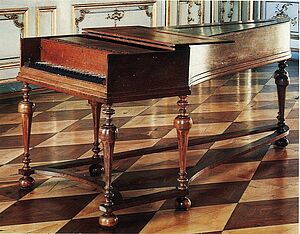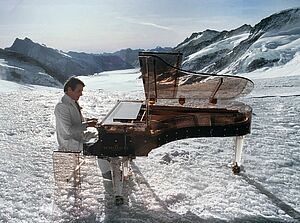A3 The production of two copies for the museum of the Wilhelm Schimmel piano factory in Braunschweig
The overview of the context of one's own craft training arises only a long time later and so this contribution is created with a reverberation time of 37 years.
In 1984, following his apprenticeship, the author was commissioned to manufacture two instruments for the Wilhelm Schimmel factory museum in Braunschweig. It was a fretless clavichord and a fortepiano after Johann Heinrich Silbermann (* 1727- † 1799). Today the framework conditions can hardly be understood:
In the Fachschule für Musikinstrumentenbau Ludwigsburg, the subject "Spezielle Fachkunde" - which, as one might assume, special knowledge of piano history should be imparted - was neglected and the important foreign-language specialist literature was not included at all. The content was limited to a foray into the history of architecture, starting with the construction of the pyramids in order to get an idea of the style epochs. More and more musical historical elements were woven into the presented chronology, but not more than could easily be found in lexicons. An excursion to the collection of the Germanic National Museum in Nuremberg rounded off the matter. In the 70s and 80s, the quality of training in this area was close to zero, so that even the master's examination in harpsichord and piano making was no longer even recognized as an admission requirement for training as a restorer due to its adaptation to the needs of the industry, and this step was justified. In the one-year master class, the same worksheets were distributed as during the apprenticeship. For this reason, the author refrained from accepting the certificate from the technical college, as the master craftsman's examination itself was accepted by the Chamber of Crafts. Interested parties had to pave their own way, train elsewhere and seek closeness to science. This in turn later led to a commitment to improving training through a dialogue with restorers at the technical school - see blog A11.
The shirt-sleeved attitude "We are able to do it also!" was the reason for sad interventions in the historical instrument inventory and also revealed itself in the idea of being able to make copies of historical instruments for a company museum in which playable instruments should be presented. Of course, it was about marketing.
First, in 1981, Nikolaus Schimmel financed the re-edition of Franz Josef Hirt's book: Masterpieces of Piano Making. In his preface he writes: "In any case, Schimmel feels obliged to the traditions of European, in particular to the traditions of German piano making and those from its own company history." In a single sentence, he adjusts the focus on his own company. It is in the nature of the economy that the company that provides funding also wants to pursue its own interests.
The comforting advantage of the planned replicas was that you could gain experience without endangering the original inventory. This is how the clavichord was created based on a drawing from the Germanic National Museum, without having to measure the original again. However, no special attention was paid to the choice of materials and so what was in stock had to be used.
On the occasion of the copy of the fortepiano, one went one step further, because this was made without a drawing after a visit to the Berlin Museum of Musical Instruments. Together with Matthias König - today working for the Bechstein piano factory - who was assigned the task of a supervisor as a piano builder, the necessary dimensions were taken, which together with a few photos had to suffice. Only later did it become clear that the intention was actually to copy Gottfried Silbermann's famous fortepiano from the former Potsdam City Palace and to make it available for TV-documented concerts.
Fortepiano by Gottfried Silbermann, today in the New Palace, Potsdam
The knowledge of the Silbermann family alone was so incomplete that Gottfried was confused with his Strasbourg nephew Johann Heinrich. When the matter was discovered, essential parts of the instrument body had already been completed, for which the existing material had to be used, here: remains from the veneer production, i.e. solid wood core boards of American walnut. That alone was more than shocking, because at first glance you can see from the original that German or French walnut burl leaves were put together with mirror joints on the frame and header. It is impossible to imagine how Gottfried Silbermann's piano would have looked in this wooden robe.
Nevertheless, making a grand piano without a drawing was a challenge in itself, and since the instrument makers of earlier epochs did not work according to drawings either, one believed to walk on traditional paths, even if modern machine tools were used. The reconstruction of the soundboard rosettes alone indicated that such objects must have been based on a completely different mindset. Making the hinges was a challenge in itself, as was making the carved legs. The historically given standards had been vastly underestimated and no one was within reach who had experience with such things. In addition, there was the set time frame, because both instruments should be ready within a year and the dates for the TV presentations had already been set. For this reason, more and more helping hands were called in towards the end.
Under the given framework conditions, the production of a functioning and resilient mechanism was unsatisfactory, and so Werner Albrecht - who works today for the Bechstein pianoforte factory - had the task of acquiring the necessary knowledge in the restoration workshop of the Berlin Musical Instrument Museum - under the direction of Horst Rase - and to colplete the work there. A special problem was the use of parchment including the necessary degreasing in order to be able to ensure durable gluing. While Gottfried Silbermann used metal axles for the hammers, Johann Heinrich opted for parchment joints. After completion, the instrument could not be used for the planned marketing activities for the reasons mentioned, because it simply lacked prominence. The protest of the employees against the conditions for such tasks was documented in pencil on the underside of the clavichord soundboard and of course it also referred to the tool and material equipment, for which completely different standards apply today. Where historical instruments have never been made, you cannot fall back on anything and must first invent and manufacture useful devices yourself - e.g. for the flutings of the turned clavichord legs.
With all this, from today's perspective incredible approach, there was no lack of contacts with scientists, which seem to have been invited just for prestige. Despite numerous workshop tours, apparently no one took a close look at what was happening, because it would have been more than justified to press the stop button. However, that would also have meant a stop for the company philosophy, according to which everything seemed feasible, and the often repeated words of the operations manager Gerhard Schwichtenberg on the occasion of tours through the so-called restoration workshop are in vivid memory: "The bests in Europe". The question of the meaning of the grand piano could have been clarified on the first telephone contact with the museum: “No, we don't have the grand piano on which J.S. Bach played for Frederick the Great." In addition, the question arises of what value such a marketing measure would have had for this company in particular.
The idea undoubtedly had to do with a specific occasion, because for the company's 100th anniversary in 1985 the brochure "Vom Musikstab zum Pianoforte" was published, followed a year later by Günther Batel's "Handbook of Keyboard Instruments" with some illustrations of the clavichord and the fortepiano. The grand piano even received a representative double page, but a written comment on the meaning and purpose is missing - for the simple reason that there was no such thing. Advertising materials have to meet other requirements and science is often used as an instrument for this.
Part of the context of the development is that the Schimmel company produced around 10.000 pianos and grand pianos in the previous year - and flew Udo Jürgens to the Jungfraujoch with a grand piano made of smoked glass. Without this hype, which also caught the workforce and which many still remember today, such a dream-dancing overconfidence would have been unthinkable. “Dreamdancer” was the title of the song Udo Jürgens performed in the Swiss mountains.
Udo Jürgens with a glass piano on the Jungfraujoch
However, the copy, which has nothing to do with Johann Heinrich Silbermann, was internationally not ignored. Decades later, a Canadian colleague drove with the author to a musicological symposium and suddenly asked him if he didn't happen to know which idiot had made the grand piano for the Schimmel factory museum ... and the answer was: "He's just driving this car."
© Aurelius Belz 2021



